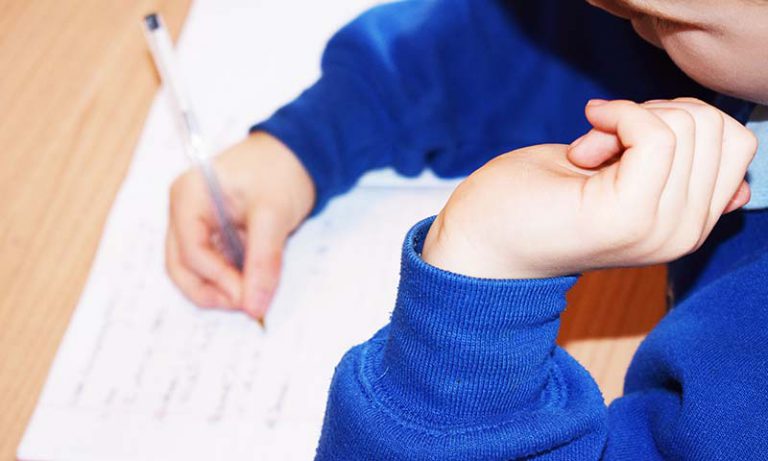
A sample of convergence insufficiency symptom survey. While your kid continues to struggle in his homework and get poor marks in exams, you probably urge him doing intensive revision, after ticking him off for a couple of hours. But sometimes his schoolwork doesn’t improve much no matter how hard you push. Before blaming his mediocrity and laziness, it is worthwhile to first bring your kid for a comprehensive eye examination - in fact many conditions related to the eyes can hinder one’s academic performance. Here I am going to introduce a few situations which gives your child torrid study time: Uncorrected refractive error, compromised binocular vision and reading disabilities.
1 Uncorrected Refractive Error
There are many types of refractive error which will not necessarily cause blur vision while being uncorrected. For example, longsighted kids can make effort to focus and restore clear vision and they may not notice that they have such refractive error. However, when they are reading, the focusing demand is higher and it may be hard for them to maintain. The kids may experience headache, blurred vision, difficult to concentrate and reluctant to do homework. Research shows that preschool children (aged 4-5 years old) showed reduced literacy level if they have uncorrected longsightedness. The near stress caused by uncorrected longsightedness also slows down the effectiveness in completing academic tasks in older students.
2 Compromised Binocular Vision
Sometimes people can see things at a distance isn’t equal to good near vision. Seeing well in one of the eyes doesn’t mean that it must also see well when looking with both eyes. Also, good reading vision at the beginning doesn’t imply the vision will be equally good after 30 minutes - these are the problems of vergence (Control both eyes to fixate at the same target to get single image) and accommodation (Focus at the right distance to get clear image) in binocular vision. Good binocular vision is established only when all of the components are well-coordinated. Below shows a survey describing symptoms of binocular vision problem such as headache, double vision and lose focus. It is believed that 25% of students have undetected visual problem and around 72% symptomatic primary school children has binocular vision issues. The survey below is for students aged 9-18 years old. If scoring 16 marks or more in the survey, your kid is probably having convergence insufficiency, which is one of the most common binocular vision anomalies.

A sample of convergence insufficiency symptom survey.
Image retrieved from https://www.ncbi.nlm.nih.gov/pmc/articles/PMC2779032/figure/F1/
3 Reading disabilities
Reading disability, or called dyslexia, is one of the most common learning difficulties happened on kids, affecting 1 child out of 10. Children with dyslexia have normal intelligence and may not have any behavioral problem, but they show unexpectedly low performance in reading, writing and spelling. These children have difficulties in coordinating the language, vision and hearing centres in the brain. They often present with visual information processing problem, meaning they cannot process what they see, link them to what they learnt in the past and output as writing in a smooth way. When dyslexic kids read, they probably see the letters being disoriented and in wrong positions as shown below:

Reading disabilities greatly disturb kids’ reading and writing, and those are not related to lacking effort and hardwork in learning. Sometimes dyslexia kids also have untreated binocular vision problem that exacerbate their reading difficulties. Children with visual information processing and reading disabilities are not necessary to have prescriptions and the problem may not be picked up by routine prescription check. Optometrists can perform binocular vision assessment and tests for visual information processing to examine the visual performance related to learning.
There are numerous possibilities when the child is not doing well at school. It can be due to lacking revision, improper learning method or even due to unhappy school life and family relationship. But from now on don’t forget that eyes may also play a role in the situation. Consult your optometrist for a comprehensive eye examination if you have concerns.
By Jeff Tang, Registered (Part I) Optometrist
Eyecare information by Swisscoat Vision Centre
Address : G/F Yuen Yick Building, 27-29 Wellington Street, Central, Hong Kong
Appointment :+852 3579 4763
Website : www.swisscoat.com
References:
Convergence Insufficiency Treatment Trial Investigator Group. (2008). A Randomized Clinical Trial of Treatments for Symptomatic Convergence Insufficiency in Children. Archives of Ophthalmology, 126(10), 1336–1349. http://doi.org/10.1001/archopht.126.10.1336
Convergence Insufficiency Treatment Trial (CITT) Investigator Group. (2009). Validity of the convergence insufficiency symptom survey: a confirmatory study. Optometry and vision science: official publication of the American Academy of Optometry, 86(4), 357.
Croucher, P. 2017 Lecture Notes (PDF-LN) Vision Development and learning 1, Vision development and learning 2. The University of Melbourne.
Nearchou C. 2ndYrOD_BV4.pdf. University of Melbourne second year OD lecture (from OPTO90023 Applied Clinical Training) (PDF-LN)
Handler, S. M., Fierson, W. M., & Section on, O. (2011). Learning disabilities, dyslexia, and vision. Pediatrics, 127(3), e818-856. doi:10.1542/peds.2010-3670
Kulp, M. T., Ciner, E., Maguire, M., Moore, B., Pentimonti, J., Pistilli, M., … & VIP-HIP Study Group. (2016). Uncorrected Hyperopia and Preschool Early Literacy: Results of the Vision in Preschoolers–Hyperopia in Preschoolers (VIP-HIP) Study. Ophthalmology, 123(4), 681-689.
Nearchou, C. (2009). Visual Efficiency Skills -Origins and Effects on Visual Perception: a Review of the Literature.
Shin, H. S., Park, S. C. and Park, C. M. (2009), Relationship between accommodative and vergence dysfunctions and academic achievement for primary school children. Ophthalmic and Physiological Optics, 29: 615–624. doi:10.1111/j.1475-1313.2009.00684.x
